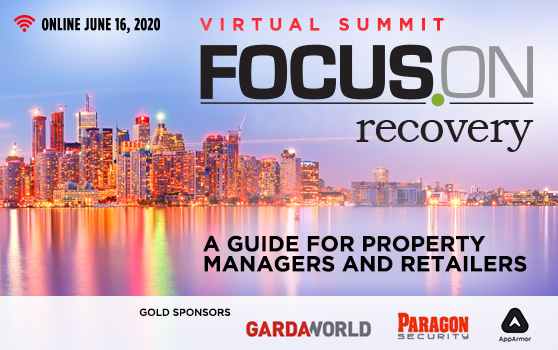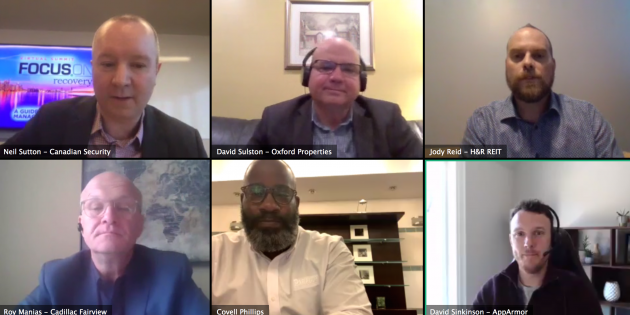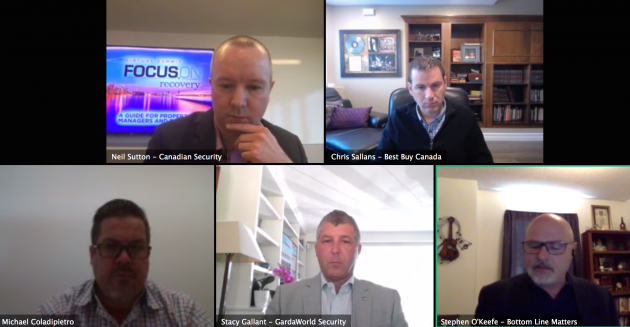
How are property managers and retailers focusing on recovery?
by Alanna Fairey, Associate Editor

Canadian Security's virtual event focused on how property managers and retailers were preparing to go back to work amid COVID-19

TORONTO — On June 16, Canadian Security hosted a virtual event called “Focus on Recovery: A Guide for Property Managers and Retailers”, which helped to provide the retail and commercial real estate industries with a blueprint on recovery steps and best practices on dealing with COVID-19.
Moderated by Canadian Security editor Neil Sutton, panelists for the virtual event included:
- David Sulston, director of security, Oxford Properties, a global property management company
- Jody Reid, security manager, H&R REIT, The BOW, a commercial property based in Calgary
- Roy Manias, senior director, security and life safety, national security operations, Cadillac Fairview, a Canadian company that invests in, owns, and manages commercial real estate
- Covell Phillips, vice-president, client services, Paragon Security, a privately owned and operated security company
- David Sinkinson, co-founder & CEO, AppArmor, a safety, emergency notification systems, and internal command and control app
In a discussion called “Commercial building management: What does back to ‘normal’ look like?”, the panelists answered the question that has been looming over everyone’s mind: what are property managers doing to prepare their premises for back to work?
Speaking on behalf of Oxford Properties, Sulston shared that going back to work involves restricting access and adding directional signage.

The panelists discuss how property managers are preparing for going back to work. PHOTO: Canadian Security
Sulston went on to explain that these restrictions take the form of reducing the number of people on elevators, installing hand washing stations and putting up signage to describe what the property is doing to prevent the spread of COVID-19.
Sinkinson shared that AppArmor’s recovery plan will prioritize the health and safety of employees and customers.
“Our game plan is certainly to return to the office when John Tory [Toronto’s mayor] says we can,” Sinkinson said. “What we plan on doing is having staff come in some days of the week, while some work remotely. And then that switches, about halfway through the week.”
Sinkinson also emphasized that his team has been taking advantage of Zoom to communicate on the steps to be taken for recovery.
Manias shared that one of the best practices that Cadillac Fairview did in preparation for reopening involved reaching out to public health inspectors prior to the openings.
“You really start to understand expectations when you’re working closely with public health in advance,” Manias said.
“We’re learning how many people are going to be allowed in the building, and then putting plans into place to make sure that those occupancy loads are maintained — the best guidance I can provide is to reach out to your public health inspector.”
Manias also shared that security will play a vital role in recovery, calling security professionals “ambassadors”.
“They are very much going to be educating, and then managing occupancy loads and working with the health inspectors,” Manias said.
In the event’s second session, “Social distancing and safety practices as retailers re-open their doors”, a second set of panelists were introduced and discussed what their businesses are doing in terms of social distancing protocols.
The panelists for this second panel included:
- Michael Coladipietro, director, risk management, Longo Bros. Fruit Markets Inc., a grocery store chain
- Stacy Gallant – director of consulting services, investigations and executive protection, GardaWorld, a security services company
- Stephen O’Keefe, president, Bottom Line Matters, a small business consulting firm
- Chris Sallans, vice-president, retail operations & geek squad, Best Buy Canada, a consumer electronics retailer

A second set of panelists discussed what their businesses are doing in terms of social distancing protocols. PHOTO: Canadian Security
Gallant shared that GardaWorld offered security services to retail and commercial clients to enforce social distancing measures.
“Our security personnel have been working to enforce line queuing entry and exit strategies to count the number of people going in and out so you’re maintaining that number and you’re not exceeding what you should have in your store or your facility,” Gallant said.
Gallant also went on to say that GardaWorld also assisted some of their clients with temperature checks as people enter retail locations.
When Best Buy Canada began to prepare for reopening, Sallans shared that the number one priority was not only finding ways to limit the number of people in-store, but to have enough supplies in the event of a second wave.
“We went through the mad scramble for N95 masks, and sanitizer that is 99% alcohol sanitization,” Sallans said. “This is a new reality that you have going forward.”
Other social distancing initiatives that Best Buy Canada took included installing plexiglass throughout the store, staff break rooms and distribution centers.
As for temperature checks at Best Buy, employees use an app.”Staff at the distribution center typically do a health check every morning and they can take their temperatures from home,” Sallans said.
When looking at implementing a pandemic plan during reopening, Gallant stressed setting actions for accountability.
“I think the best place to start in this is documenting your efforts and keeping track of what you do,” Gallant said. “If something comes up you can easily document it to show what steps you took throughout the course and your recovery as it is now.”
Gallant emphasized that businesses’ reopening plans need to be flexible, due to the rules surrounding COVID-19 changing on a daily basis.
“Part of that plan is communication. At all times, your staff and your customers want to feel safe, and that perception of what you’re doing goes a long way to make sure they’re tracking people at work,” Gallant concluded.
The full panel discussions can be viewed on-demand on Canadian Security, one of Canadian Manufacturing‘s sister publications.